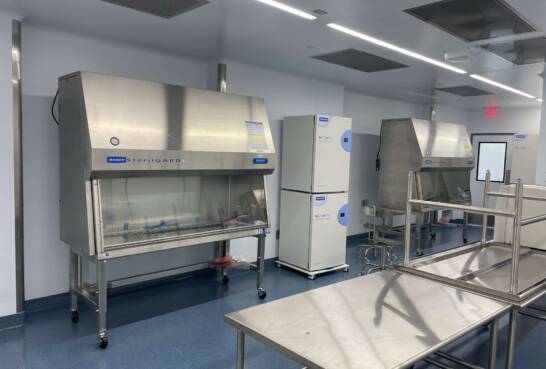If your lab equipment isn’t performing to its fullest potential, should you consider repairs or a complete replacement? If you have an older unit that still works, how do you know when it’s time for a new one? It’s important to make the right decisions for your lab, and investing in new products versus repairing older ones is a major financial decision — but there are times when it’s worth it and even necessary.
8 Reasons Why You Should Update Your Lab Equipment
When Should You Replace Your Lab Equipment?
FAQs
8 Reasons Why You Should Update Your Lab Equipment
1. Safety issues
There are many components to laboratory safety, including wearing the appropriate personal protective equipment and the proper handling of hazardous chemicals and materials. But don’t overlook the importance of equipment when it comes to ensuring the wellbeing of lab personnel and the preservation of lab samples and research.
If there are any issues with a piece of equipment, a specific part (or perhaps the entire unit) may need to be replaced. Keep in mind that some safety issues such as faulty ductwork or wiring may not be completely visible, but if there is any concern for immediate danger, you should immediately turn off and unplug the piece equipment. For example, centrifuge rotors spin at a high rate of speed and over time can develop hairline cracks or corrosion. If you’re worried about a rotor, a manufacturer representative can inspect it and see if there is a cause for concern.
Other common safety issues could include damaged cords, leaks, faulty electric wiring, corrosion and broken glass. Be mindful of dings and dents that may indicate internal damage to the unit that isn’t visible to the naked eye.
2. Increased downtime
Some equipment downtime is to be expected, but if you are constantly stopping to fix or replace certain parts or components, you are not being efficient — and your research can suffer. Increased downtime can often lead to timeline delays, a higher risk of sample contamination or additional project costs.
3. The need to constantly recalibrate
Most types of lab equipment have a calibration protocol. But recalibrating more than usual can lead to an increase in downtime, which, as we just discussed, can cause unnecessary project delays and costs. Plus, failure to recalibrate (or doing so incorrectly) will often result in inaccurate data.
4. Automation and increased accuracy and precision
Certain types of lab equipment now include a variety of automated, time-saving features. The DeNovix CellDrop FL Cell Counter, for example, enables you to count cells with just the press of a button, which means you are free to focus on other tasks. Not only will this save time, but it ensures a higher level of accuracy and helps avoid human error.
5. Advanced technology
Lab equipment technology is constantly evolving, and newer models have the latest features, many of which can increase efficiency and save time. Examples include:
- Temperature monitoring and alarms: Temperature monitoring used to be a paper chart recorder that had to be replaced every week. New monitoring systems are cloud-based, which allows for easy data collection and can even notify users of a temperature deviation via phone or email. Newer refrigerators and freezers now come with access ports, which allow for temperature probe access.
- Flashing LED screens and airflow monitor (AFM): New biological safety cabinets come with several new safety features, including a sash sensor, which tells you when the sash is not in the proper working location. Air flow monitors will alarm when the facility exhaust system is not at the correct specifications; there are also safety interlocks with the sash and UV light that ensure no one is accidentally exposed to UV light.
- Touchscreen monitors: Intuitive controls allow for easier use and data collection and provide more feedback. Some monitors may also log temperature changes by tracking when the unit’s door is open, and select models feature face recognition software that adds an additional level of security.
6. Energy savings
It’s no secret that lab equipment uses a lot of energy — with ultra-low freezers being one of the worst offenders. According to the U.S. Department of Energy, an ultra-low temperature freezer uses the same amount of energy per day as the average household.
The good news is that newer lab equipment uses less energy, and many models are now designed with sustainability and energy efficiency in mind. If you’re looking for a sustainable option, it’s important to confirm that your lab equipment has the ENERGY STAR® label, which will ensure that your units have the latest in energy-saving features. This is important because it will help lower your utility bills.
ENERGY STAR units reduce energy consumption through the use of more efficient compressors, advanced microprocessor controllers and innovative and environmentally-friendly refrigerants.
In addition, some utility companies may offer rebates if you purchase energy-saving equipment.
7. ROI and lower lifecycle cost
The initial purchase price of lab equipment can be expensive, but constantly replacing parts and increased downtime can add up — costing you even more in the long run.
Newer BSCs have more energy-efficient and better-performing motors, which allow HEPA filters to last much longer, thus saving money and downtime for service work. Autoclaves, in particular, have water conservation features and sophisticated controls that can automatically turn the steam source on and off so that the unit is not wasting energy but also maintains the right temperature for when the customer is ready to use it.
8. Advancements in ergonomics
Lab personnel are at risk for repetitive motion injuries and other types of physical stressors, which is why manufacturers have designed equipment with ergonomics in mind.
Many biological safety cabinets feature a 10° slanted viewscreen, which provides a more natural position when working. Padded armrests allow for additional comfort, and
cable ports offer easier and safer access.
The Class III BSC model and all horizontal and vertical flow hoods offer an adaptive ergonomic design, including stainless steel gloveports built directly into the viewscreen. The viewscreen, which is scratch resistant and protects against most decontamination agents, provides maximum safety and reduces eye strain.
When Should You Replace Your Lab Equipment?
Reputable manufacturers are happy to help with repairs, but keep in mind that lab equipment is continually evolving, which means you may not be able to order a part for a unit that is a decade or older.
There is no hard-and-fast rule for when to replace lab equipment. But we recommend looking at new models if your unit is more than 10 years old, especially because it may be more cost-effective to budget for new equipment rather than invest in expensive repairs. NSF/ANSI 49 — the national biological safety cabinet certification — recommends replacing a BSC every 15 years.
If your lab is exploring sustainability measures, an ENERGY STAR unit is an excellent way to meet energy-efficient goals while saving money and reducing your carbon footprint.
New lab equipment does come with a warranty, but there are often restrictions. A typical restriction is covering parts but not labor, which is the most expensive part of most repairs. Some warranties require a preventative maintenance program, and if you don’t have this, your warranty is not valid.
FAQs
Q: If you aren’t 100% sure whether your lab equipment needs to be replaced, what should you do?
A: You need to first determine the age of the unit and whether the product is still supported by the manufacturer. If you aren’t sure when the unit was purchased, you can provide us with the serial number, and we can recommend a service company that can take a look at your unit.
Q: How do you know whether it’s more cost-effective to replace a part or two versus completely replacing the unit?
A: An independent service company can provide you with a quote so that you have a good idea of whether it’s financially beneficial to repair versus purchase new.
Q: How can you help ensure a piece of lab equipment stays in good working condition?
A: Be proactive. Routine and preventative maintenance are key to ensuring your equipment stays in the best condition possible. If you’re working with a lab equipment provider, your local representative should provide tips and helpful information on annual maintenance. Make sure you have a plan in place — don’t wait until a unit completely breaks down.
Discover How Upgrading Your Equipment Could Benefit Your Lab
If you’re considering a unit upgrade, or would like additional information, we invite you to contact us. Our free, no obligation consultation call is the best way to ask questions and get the information you need to make an informed purchase.
The experts at D.A.I. Scientific are familiar with every type of analytical laboratory in the pharmaceutical, educational, clinical and biotech industries. What sets us apart is our commitment to understanding and supporting our products.
Whether you need a single replacement unit for your laboratory or an entire equipment package for a new building, we are a one-source provider for all your laboratory equipment needs.



